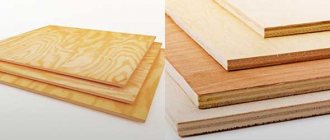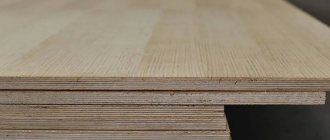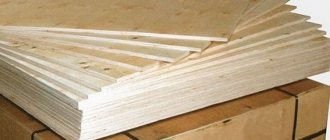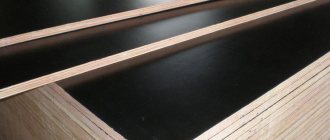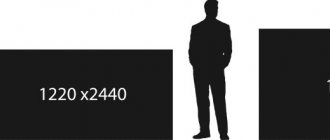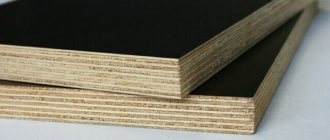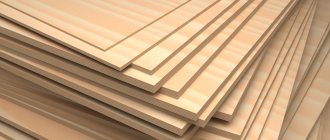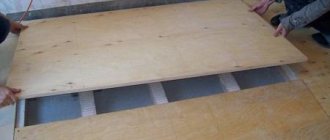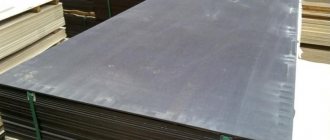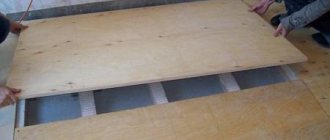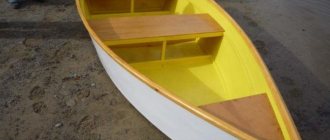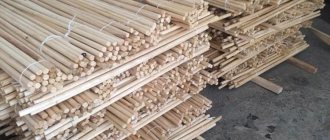The concept of “plywood” is a collective term that combines sheets glued together from three or more layers of wood veneer. Wood fibers are usually perpendicular, which allows plywood to hold its shape and resist dynamic loads.
Currently, FK and FSF . However, disputes between finishers about the quality of products and their environmental safety continue. Let's try to understand this issue.
Decoding abbreviations
First, let's look at the definitions. In both cases, we are talking about material made from certain types of wood. It usually looks like this:
- birch - all layers of plywood sheet are made from this type of wood.
- coniferous trees - pine is used as a raw material.
- combined options - the outer layers are made of birch, the inner layers are made of pine.
What's the difference? All plywood on the market differs from each other in its adhesive composition. In deciphering the abbreviation, the first letter indicates the name of the material. In our case, “F” stands for plywood.
Further symbols identify the glue that was used to make the sheet. In particular:
- K – urea-formaldehyde.
- SF – phenol-formaldehyde resin.
The difference in adhesive composition largely determines the technical properties of plywood. For example, the material of the FC is more often used in the production of cabinet and upholstered furniture.
FSF - more suitable for interior partitions and billboards.
The scope of application is determined by the fact that the resin phenol-formaldehyde makes the sheets more resistant to humid environments.
Description
FK grade plywood is used for the manufacture of containers and packaging, as well as in construction and furniture production.
The basis for this type is wood veneer, peeled in a special way, from pine or birch. As a rule, the finished sheet of material is glued together from several layers of such veneer - from 3 to 5. Accordingly, the thickness of the plywood sheets varies. An adhesive based on phenol-formaldehyde resin is used. Although a maximum of two types of wood are used to make FSF, the sheets can be of three main types. These are structures made exclusively of birch or pine veneer, or a combined sheet, inside of which there is pine veneer, and on top everything is covered with birch.
FSF plywood has quite good properties in practical terms. This is resistance to impacts and various mechanical damage, resistance to all types of moisture, and also ease of processing, which is also important, especially if you are going to do construction or repair work yourself.
Such sheets are most often used for the manufacture of furniture and various interior partitions. They are also often used to make large billboards. But for frames and roof supports they are one of the most reliable and inexpensive materials.
So, the main characteristics of these two types of plywood are briefly discussed. Now is the time to summarize and name the main differences between FC and FSF plywood. This will help you make the right choice of the specific type of material for the job. FC plywood differs from FSF plywood primarily in moisture resistance. But let’s describe everything in more detail according to the main criteria.
Key differences between the submissions
The use of different adhesive compositions requires each type of plywood to have its own technical features and scope of application. The table compares the two materials.
| Comparative review of two types of plywood | ||
| Criterion | FC | FSF |
| Fire safety* | Low | Low |
| Environmental Safety | No phenol | Phenol is present at a concentration of 8 mg/100 g** |
| Moisture resistance | After getting wet and then drying, it delaminates | Does not delaminate after being in a humid environment |
| Scope of application | In rooms with low humidity | Indoors and outdoors (under canopies, in outbuildings) |
| Gluing | Urea-formaldehyde composition | Phenol-formaldehyde composition |
| Flexural strength MPa | 45 | 60 |
| On a leaf cut | Single-color, light (layers of veneer and glue are the same color) | Multi-colored, light veneer layers are combined with dark adhesive |
*If you need non-flammable plywood, choose FSF-TV , impregnated with a special compound. It is used in passenger carriage construction.
**Assigned safety class E-1 - permission for use in residential premises. However, in some rooms, especially in the nursery, it is undesirable to use.
In terms of presentation, both types of plywood are identical. There are several categories here: the higher the class, the fewer external defects.
Regardless of these features, FSF is more often used for rough work, while FC has the function of finishing.
FC and FSF plywood, what is the difference
All varieties of this sheet material are created the same way. Several layers of thin wood veneer are glued together to create a sheet of the required thickness. The differences lie in the details:
- wood type;
- type and composition of glue;
- gluing technology.
Materials of different categories can be distinguished by eye. If you look at the end, FC’s is lighter, while FSF’s is darker, often reddish. This is due to the fact that the adhesive composition used for FC becomes transparent after drying.
Another difference is the price. Among 2 plywood sheets of the same size, FSF will cost significantly more. But the characteristics of the latter are much better. We'll talk about them in more detail later.
Look to the root! Visual differences
Visually, both types of plywood are very similar. Similar types of wood veneer are used here, laminated coating and sheet sanding are provided. However, there are external differences, and they are due to differences in the adhesive composition.
FC plywood does not contain phenol, so it looks lighter. The layers and sheets of veneer have an identical color scheme, so they look like a homogeneous material. FSF has layers of a dark red hue.
Knowing these features, it is easy to distinguish between types of plywood, even without special skills and knowledge in the field of construction.
general characteristics
Wooden plywood is a common material used:
- during construction and finishing works of interiors, roofs, facades and others;
- in experimental and design modeling;
- in packaging production;
- for the needs of various industries, including aviation, mechanical engineering, and railway transport.
These products are layered panels or slabs of varying thicknesses made from wood veneer, pressed and glued together.
Which is safer for your health?
If environmental safety plays a decisive role, it is better to choose FC . Here, silicate glue is used for gluing sheets, which is a neutral artificial material without chemically active additives.
In the case of the FSF, the issue is controversial. GOST requirements applied to this type of material, the phenol content in the composition does not exceed the permissible values. In addition, this substance is actively and widely used in medicine, agriculture and even the food industry.
However, in terms of toxicity, the component belongs to the second class of chemical hazard. This means that there is only a thin line between acceptable and exceeded concentrations. Therefore, if you want to maintain a healthy atmosphere in your home, it is better not to take risks.
How do the materials differ?
How are the materials different? After the main characteristics of these two products have been considered, it is worth dwelling on the differences between FC and FSF. Thanks to this, each buyer will be able to choose the right option and complete all their work quickly and efficiently. The most important difference between these plywoods is moisture resistance. But this is not all, so let’s look at each criterion in more detail:
Safety
In this case, the glue that is used for gluing sheets of plywood deserves great attention. Since it was previously said that formaldehyde resins are used to produce PSF, we can say that the final product releases harmful impurities into the atmosphere. Consequently, such material poses a danger to human health. When producing FC plywood, the composition used is less safe. To summarize, it should be noted that FC plywood can be used for cladding inside the house, as well as in the production of furniture. But it is not recommended to use the FSF for these purposes. This version of plywood is best used for external structures, the location of which will be on the street.
Moisture resistance
According to this criterion, FSF plywood is considered the leader. It is characterized by higher levels of moisture resistance, for this reason it is allowed to be used in all areas. As for FC plywood, it will be amazed by its low moisture resistance. It cannot be used for cladding wet rooms or for streets.
Strength indicators
In this case, the FSF also occupies a winning position. For this reason, such a product is widely used in the construction of rigid structures where there will be a large load in the future. As for FC, you should not place high hopes on these sheets; therefore, it is not recommended to use them for the production of supporting structures or serious furniture parts.
Decorativeness
In this criterion, both products are on par. Decorativeness here is determined by such a criterion as quality. The higher quality the product, the fewer various defects on its surface. According to the experience of builders, most often they use FC plywood for decoration, but FSF is used as a base.
The characteristics of grade 4 4 plywood are listed in this article.
Main differences
To more clearly distinguish between these two types of plywood, we offer a brief comparison of them.
So, FC is absolutely safe for health, is not resistant to moisture, is suitable for interior work and furniture production, is fragile and does not withstand mechanical stress, easily breaks and delaminates.
While FSF has low environmental friendliness, which is why it can harm humans and animals, it has excellent moisture resistance, is applicable for interior, facade, and any other external work, and has increased fracture strength and pressure.
Comparison
Thus, there is more than one difference between FSF and FC plywood, and all of them can be classified as significant.
Firstly, the materials in question differ in chemical composition. The first type of plywood contains phenol; the material classified as FC does not contain this substance.
Secondly, FSF and FK plywood differ in purpose. The first type of material is used mainly for exterior decoration of premises, the second - for interior decoration. This is due to the undesirability of placing plywood, which contains phenol, indoors, as well as the fact that the FSF type material is more resistant to moisture.
Thirdly, you can trace the differences between FSF and FC plywood in appearance. The first type of material on the cut is multi-colored (you can see light stripes of veneer and dark stripes of glue), the second is one-color, light.
Fourthly, FSF plywood is stronger than FC. Therefore, it can be used for the installation of building elements that carry a noticeable load. It is problematic to use FC plywood in this way.
Having determined what the difference is between FSF and FC plywood, we will reflect the conclusions in the table.
Application of FSF
FSF plywood is considered a moisture-resistant material and more expensive. Its production uses both birch and coniferous veneer.
It can be used outside buildings, in places with high humidity. Thick FSF sheets are durable and wear-resistant. They can be impregnated with fire retardants, as a result of which the plywood receives fire-resistant properties. This type is designated FSF-TV. It is used in passenger railway carriages, often laminated with decorative film.
FSF sheets are used as roofing material for the construction of stages, sports fields, temporary structures, and billboards. Such plywood is widely used for formwork, and the best option here is laminated material, since it can be used several times (up to 100).
Although furniture for residential premises is not made from FSF, it is excellent for garden benches, gazebos and other structures. Another common application is truck floors and van linings. It is allowed to make boxes for transporting non-food products from FSF sheets.
Which plywood is suitable for joist floors
Before you start arranging plywood floors along the joists, you should clearly understand what kind of floor you need to make: rough or finished. It is necessary to select a material taking into account the following parameters:
- Base type . Concrete has high thermal conductivity; sheets with a thickness of 15 mm or more can reduce heat loss. And the thickness of the plywood for the floor along the joists, if this is a rough version, is 12 mm.
- Type of premises . For residential use, the FK variety is recommended; it is the most environmentally friendly.
- Sheet thickness . If plywood needs to be laid on joists, it is necessary to correctly determine the thickness of the disc; the service life of the subfloor depends on it. But here it is important not to go too far: the thicker the board, the greater the mass of the flooring, and this is an additional load on the joist structure.
What to look for when choosing plywood?
The brand, grade and thickness of plywood are the main criteria that are used when choosing a material.
Guests may differ, but it is better to always check the quality of the material yourself. To decide which plywood to choose, first inspect the edges of the material. In high-quality plywood, the inner layers of veneer should be straight, of the same thickness, without overlaps or gaps. The heterogeneity of the internal layers not only worsens the performance qualities of the material, but can also appear on the outside of the plywood sheet and create unnecessary problems when cutting it and at the finishing stage.
Before purchasing plywood, it would be a good idea to visually assess the straightness of the sheet. Even a small bend can turn into serious warping due to the release of internal stresses after the sheet is cut.
The choice of any variety (modification) of products from one group of products always raises many questions. The main reason is that even a specialist sometimes finds it difficult to find differences between samples, since in many respects (size, appearance, color design, and so on) they are often almost identical.
For a potential buyer, it is even more difficult, since it is not always possible to place the products side by side and make a comparative analysis of the structure, shades or something else. This fully applies to plywood. FC and FSF have differences in individual characteristics (physico-chemical, technical), which determine the specific application of the sheets. So what is it?
Focusing only on the abbreviation indicated on the plywood price tag is not entirely correct. Moreover, the difference between FC and FSF plywood is not only in some operational parameters, but also in cost (although not so significant). It is hardly appropriate to rely on the professionalism and integrity of the seller if the building materials are not purchased at a specialized retail outlet. Therefore, when purchasing, be sure to carry out an external inspection of the sheets. Such meticulousness will help not only to identify defective samples, but also to make sure that this is exactly the type of plywood that is needed.
Unfortunately, there are often cases when unscrupulous traders resort to obvious forgery, relying on the incompetence of the buyer. Otherwise, it is not a fact that after the repair, in a short time you will not have to deal with restoration, alteration, or even complete dismantling of the entire structure.
FK and FSF plywood have a lot in common. This is what often confuses potential buyers. For example, both plywood belongs to the category “moisture-resistant”, “multi-layer”. And the types of veneer are the same - coniferous (pine), deciduous (birch, sometimes alder in FC) or a combination. The fundamental difference is in the adhesive composition, as evidenced by the product labeling.
- F is the letter in the first position in the designation of all modifications of sheets. It simply stands for plywood.
- K – urea-formaldehyde composition.
- SF is a slightly different glue, resin formaldehyde.
It is the means used for fastening the veneer in these modifications of the wood-laminated board that determines the properties of a particular type of plywood.
Ways to level a floor using plywood
The sheets are large in size, which makes it possible to reduce the number of joints when installing a covering of a large area. At the same time, the strength and service life of the structure increases. Sufficient thickness of the sheets also helps to increase the reliability of the coating. You can level the floor in different ways.
Installing plywood on a concrete floor
Method 1: installation on concrete screed
There are several options:
- Frame on joists. The structure is based on timber, which allows the floor to be insulated (thermal insulation is placed in the cells formed during the sheathing). This option is the most labor-intensive. Its disadvantage is the reduction in the height of the room.
- Anchor mounting. The fasteners secure the plywood sheets to the concrete base. By adjusting the anchor pins the floor can be leveled.
- Application of adhesive composition. Features of fixing sheets up to 12 mm thick: the concrete base is carefully leveled, leaving up to 4 mm of a gap around the perimeter of the room in case the material expands when operating conditions change.
Plywood grade markings and sizes
The grade is written after the plywood size in Roman or Arabic numerals. The sides of the sheet may be of the same type, or they may be different.
What is the meaning of plywood markings?
Plywood marking
Example of marking:
- “FSF plywood 1525×1525×9 mm, 4/4” - stands for: FSF plywood - FSF brand plywood, 1525×1525×9 mm - sheet size: length 1525mm, width 1525mm, thickness 9mm; 4/4 – grade 4/4, i.e. both sides of the sheet are of the same grade (in this case, grade 4)
- “FSF plywood 1525×1525×9 mm, 2/4, Ш2” - the difference compared to the first option: 2/4 – grade 2/4, i.e. one side is 2nd grade 2, the other is 4th grade; ШЛ2 – i.e. polished on both sides.
How to choose plywood
To choose between the types described above, you should be guided by the scope of application. So, if you need an environmentally friendly material for work inside the house, then FC is suitable. And when strength and fire resistance are important, its “rival”.
Important points:
- Each plywood sheet must be marked. This is data on the category of material, type of wood, glue composition, thickness and size of the sheet, and degree of emission. To understand the labeling and always know what you are buying, you should read GOST 3916.2-96 - it’s exactly about this.
- Conscientious sellers do not hide what materials they have in stock. But just in case, you need to be able to distinguish FC from FSF.
- FSF plywood is always more expensive than FC. If it is suspiciously cheap, it means it is of poor quality and was made by someone unknown and where. The opposite rule works with FC - an inflated price does not mean that it is of better quality.
It is also worth paying attention to plywood of the FB category. Bakelite varnish is used for impregnation, and water-soluble (less often alcohol-soluble) resins are used as glue. This material combines the best qualities of both types, is environmentally friendly, but due to its specific composition it does not have a wide range of applications. It is suitable only for finishing – both internal and external.
